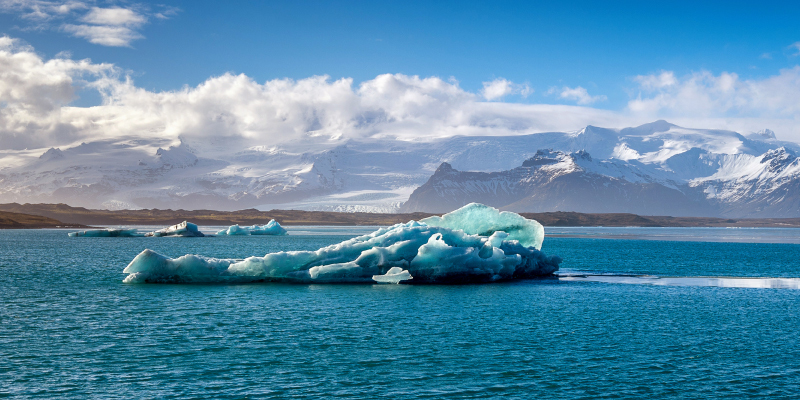
The world’s environmental makeup is changing for the worse every day. The Earth’s temperature is steadily rising, large-scale pollution is going unchecked, seasonal changes have increased sharply, more animals are going extinct, and it’s becoming harder to access clean air and water. All thanks to climate change!
One of the most dangerous consequences of climate change is the ice caps melting and water levels rising across the globe. For years, scientists have been warning everyone about the ice at the poles melting and the catastrophic consequences it will have, especially on the oceans.
So, what will happen if all the ice in the world melted? This World Ocean Day, let’s take a look at those consequences.
First, let’s clarify what we mean by ‘all the ice in the world’. About 99% of all the freshwater in the world is frozen and can be found in the form of ice caps, glaciers, and just ice or snow, in Greenland and Antarctica. The rest of the one percent is divided among different parts of the world – some as glaciers in the Himalayas and some as permafrost in the Arctic tundra. Permafrost is the layer of soil underneath the top layer that remains below the freezing point at all times. Within it are flora and fauna that have been frozen for millions of years. This is mainly what counts as ice in this context.
The first and most immediate consequence of all the ice melting is that all the freshwater will flow out and join the oceans, thus rendering it unusable. Yes, all the ice melting would mean we say goodbye to most freshwater on Earth.
This will then cause the water levels of all the oceans (and consequently the seas and rivers as well) to increase. Scientists have calculated that it would increase by 66 metres or 216 feet. Talk about swimming in the deep end! This would mean that all coastal towns and cities like Mumbai, London, New York and low-lying island countries like Japan, would find themselves underwater. That in turn would displace about 40% of the world’s population.
But wait, the inland cities and towns wouldn’t be safe either. An increase in saltwater would lead to it seeping into groundwater systems. Yes, those are the same systems we use to get water that is used to drink, cook, bathe and water our crops. The saltwater will contaminate the groundwater systems, shutting off all access to clean, usable water.
The mixing of freshwater and saltwater would also affect ocean currents and weather patterns. Some experts even predict that it would lead to a mini ice age in Europe. Of course, it wouldn’t last long as the extremely high temperatures on Earth at that point would melt even that ice. According to NASA, if all the ice in Greenland were to melt and enter the ocean, it would change the way the Earth rotates! The increase in water would slow the Earth’s rotation, which would mean longer days, even if by mere seconds.
What about the last one percent, you ask? Unfortunately, that’s even more dangerous! Himalayan glaciers contain many toxic chemicals like dichlorodiphenyltrichloroethane (DDT). If these enter our rivers and lakes, it could lead to us being poisoned.
Similarly, with the permafrost in Antarctica. Permafrost has been around since the dinosaurs. So, not only does it have some amazing fossils, but it also carries many ancient bacteria, viruses, and microbes, which could have adverse effects on living things. Scientists have also estimated that there are about 15 million gallons (6, 81,91,350 litres) of mercury inside the permafrost, which would be released into our ground and water once it’s thawed, leading to mercury poisoning.
What’s more, a thawing permafrost could accelerate global warming. Permafrost is essentially decomposing matter that has been frozen for centuries. Once it thaws, it will start decomposing or rotting at a faster rate. This would release more greenhouse gases into the atmosphere, increasing the Earth’s temperature by a lot.
It may not be comforting to read these theories that may or may not happen. But it is important to know that it will definitely happen if we don’t come together to stop climate change immediately. These theories will turn into reality if we don’t take the environment seriously. So, let’s vow to keep that ice frozen for as long as we can.
What would you do to help the oceans from overflowing and changing? Let us know in the comments.
Curious about what the Earth may have looked like in a different universe? Find out more with Knowledge Vine:
What if the earth stops spinning?
What if the Earth’s oxygen level doubled?
1. How long will it take for all the ice to melt?
There are more than five million cubic miles of ice on Earth, and some scientists say it would take more than 5,000 years to melt it all.
2. How much ice is left in the world?
The loss of ice has alarmingly increased in the past decade. A recent study showed that the Earth has lost a whopping 28 trillion tons of ice between 1994 and 2017, averaging more than 1.2 trillion tons a year.
3. Will there be another ice age?
Scientists did predict that there may be another ice age, but with accelerated global warming, another ice age would not happen for another 50,000 years at least.
4. Is there land under Antarctica?
Yes, there is some land under Antarctica, but it is only now being mapped. It remains to be explored.
Madhavi is passionate about everything to do with books, art, literature, films, trivia and food. A former journalist, she believes that asking questions makes life interesting.